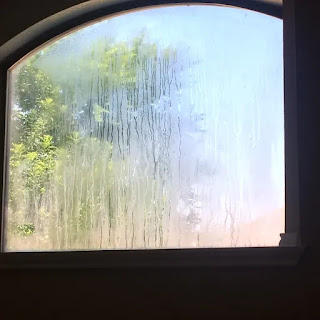Parrish Blue
After finding a coffee table book under my Moms bed when I was 12, snooping the way kids do, the story enthralled me even then!
My mom was a huge Parrish fan. In the 80's, our home was decorated in a style similar to his paintings; ample light, palms and pillars, terracotta against draping fabric....and cobalt...always cobalt. Parishes' use of mixing lapis lazuli against white became his trademark "Parrish Blue", as it became known. It is the color of evening...full moon against sky and night languages!
Maxfield Parrish was one of the few artists who enjoyed fame for his work during his lifetime. He was regularly featured in Harper's Bazar and Scribner's.
He married a young art teacher named Lydia Ambler Austin. Lydia deserves a story of her own. A truly remarkable woman! After having 4 children, Lydia's life left little room for art as she was deep in the throws of the everyday life; keeping house and raising children. In need of help, the Parishes hired a young maid of 16 by the name of Sue Lewin, to help keep house and watch over babies.
It was not long after that Parrish took Sue as model for his paintings. You will see in all of his work, from that time on, a figure that was always Sue. Through the years as girl, maid and woman, costumed in robes and swaths of fabric and sometimes hardly dressed at all!
An art studio over an outbuilding of the Parish estate became Sues home. People whispered and gossiped about the arrangement, but Parrish was always adamant that he and Sue's relationship was strictly professional. Sue also remarked that "Mr. Parrish has never seen me above my knees."
By 1923 Lydia Parrish was troubled enough by the relationship to go to her friends, Winston and Mabel Churchill and profess she needed help to save her marriage and "relocate" Sue. The Churchills provided occupation for Sue at their home, Harlakenden, a mansion in Cornish. Sue moved in and tended the grounds while the Churchills were away. Only, months later, a curious fire burned the residence down and Sue subsequently moved back into Shady Oaks studio where she lived over the next 40 years. Over this time, Sue appeared in all manner of poses and postures in Parishes' paintings.
Some of Maxfield Parrishes' greatest work came out of this period. By this time he had refined his reputation as a master of color against light which is often referenced when discussing his large body of work.
The pain of never exposing his feelings for Sue has always brought me to great dismay. Because when Maxfield Parrishes' wife Lydia died in 1953, it was whispered that he and Sue might marry. Their closeness was known to people. But he didn't ask Sue to marry him. So, by 1960, Sue said "yes" to marrying another man who had pursued her for years.
When Parrish died, he left all of the "Servants" including Sue an identical sum in thanks for their service to the estate. In fact, there was never anything that Parrish gave to Sue that was publicly out of step with his duty.
Parish only painted landscapes after Sue ceased to be his model. The last painting she appeared in was called, The Enchanted Prince.
But when his studio was sorted after his death a stash of pictures Kept in a hidden place was found, and they were all of Sue Lewin and her willowed poses for his paintings. Her body was not kept from him and her eye seem to cast a certain something toward him. Sues poses are the ones seen in parishes most famous paintings.
Alma Gilbert was the author of the books my mom kept under her bed. She is the leading authority on Parrish's life and artwork and had amassed a collection of originals and had them on display in San Francisco near where I grew up. My mom and Dad went to her studio a time or two. It was said that before her death, Sue was going to come talk to Alma to tell her everything. But tragedy struck and Sue died days before their meeting, never to divulge the Sue's side of things.
It has pained me to research this article, as no reading material can be found on Lewin herself. Even though she had been muse and assistant to Parrish for 50 years, she seems to have dissipated into nothing but a stroke of light or smoke on canvas. Yet Parishes' paintings remain and like any artist with a good muse, long from now people will look at the woman on canvas and wonder "What provoked this painting? Who was that woman?"



Comments
Post a Comment